Table saw push sticks are an essential but often overlooked tool when you're doing woodwork.
The best table saw push sticks make the difference between a perfectly straight cut or a skew one.
Whether or not you use a push stick can also determine if you get to keep your fingers!
Comparison of the Best Table Saw Push Stick
| IMAGE | PRODUCT | |
|---|---|---|
Our Top Pick  |
| View Latest Price → |
 |
| View Latest Price → |
Best Budget Option  |
| View Latest Price → |
 |
| View Latest Price → |
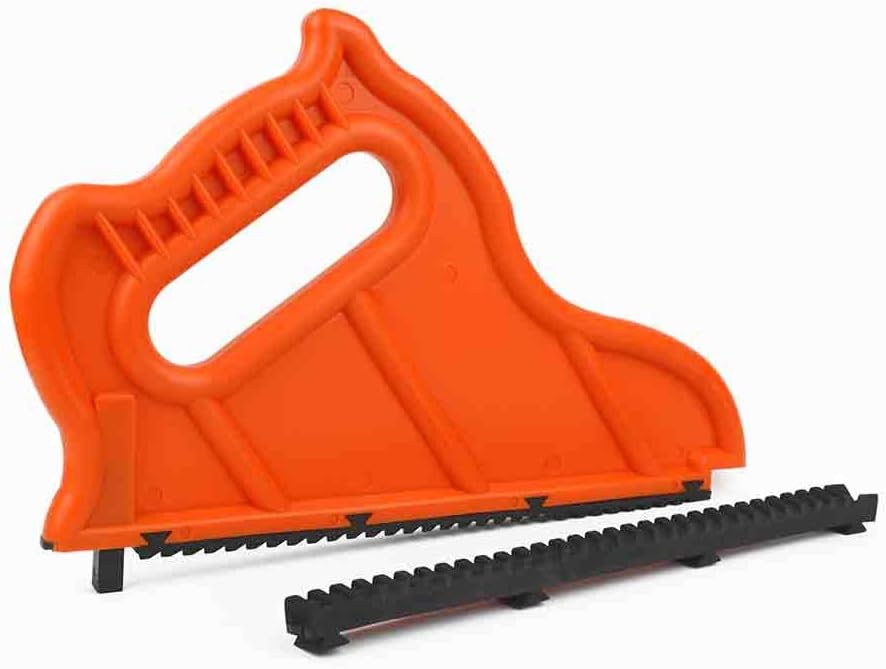 |
| View Latest Price → |
How Do I Choose a Table Saw Push Stick?
Choosing an ideal push stick for your table saw doesn't have to be as complicated as you think. The five main aspects you need to consider are:
- Safety
- Comfort
- Length of the push stick
- Adjustability
- Affordability
Safety
Safety is an essential criterion for these tools. The best table saw push sticks should keep your hand away from the blade but also prevent kickback. Ideally, that means a long enough tool that doesn't apply pressure only to the stock's back edge.
Comfort
Ideally, you want this type of tool to fit comfortably in your hand. However, some push sticks substitute comfort for safety, which you also don't want.
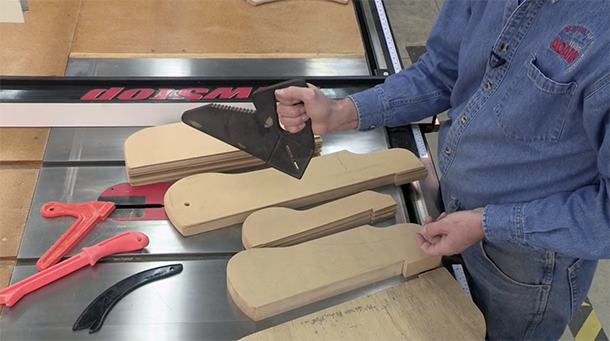
Photo credit: PopularWoodWorking.com
Push Stick Length
The length of the stick becomes critical when you start cutting narrow stock. If your push tool isn't long enough, your hand will still be in the way of the blade.
Adjustability
Depending on the kind of project you're taking on, you want to be able to adjust various elements of your push tool. It's not as essential for a push stick that rests atop your stock (AKA wood).
Affordability
The best table saw push sticks protect your hands from the blade. The tool shouldn't be so expensive that you're worried about damaging it.
Review of the Best Table Saw Push Sticks
We know that finding the best table saw push sticks can be an intimidating mission. We've reviewed a few of the best products on the market to help you decide.
Best Overall:
POWERTEC 71338

PROS
CONS
What Recent Buyers Report
Most recent buyers seem pleased with the product. They're especially fond of the control that the rubber grip strip adds. The other thing they love is the grid design, which leaves space for sweat to dissipate. However, many customers express concern about how close this stick brings your hand to the blade.
Why it Stands Out to Us
Several features prompt us to recommend this tool.
The first is the L-shaped design. As we mentioned before, tools that place all the pressure on the stock's edge aren't ideal. The L-shape places pressure over a significantly larger area.
The second significant feature is the width of the stick. Since this tool is considerably narrower, you can use it to cut thinner wood stock.
The final noteworthy aspect is the replaceable grip strip. While cutting, one can often nick the rubber on the bottom of the tool. Since this section is replaceable, you get more value.
Bottom Line
This product has both good and bad aspects. Overall, the fact that you have better control is brilliant. The extended contact with the stock and the grid design adds an extra layer of security. However, the tool is relatively short, and many users find that it brings them uncomfortably close to the blade.
Runner-up:
Safety Woodworking Push Stick 2

PROS
CONS
What Recent Buyers Report
There are mixed reports from customers about this product. We noted a few complaints about the handle design being too large or not having enough grip. However, many other customers applaud the long, narrow design. They claim that the tool makes it easy to cut thin stock.
Why it Stands Out to Us
The central aspect that we like about this tool is that it keeps your hand far above the blade's reach. We're also partial to the fact that the relief circle eases the stick quickly off the stock.
Incorporating magnets into the handle was a stellar idea since it makes it easy to keep it in reach. However, the tool also includes a traditional hole for hanging if your saw's base isn't magnetic.
The final positive aspect of this push stick is the bright coloration. The bright orange helps keep you in the loop about where your tool is, making it easier to see potential impacts.
Bottom Line
This tool has many positive aspects, including the relief circle in the notch for the stock. However, some users report that the handle lacks grip and that it applies pressure to the wrong part of the wood. Many consider this one of the best table saw push sticks.
Best for the Money:
MICRO JIG Store GR-100

PROS
CONS
What Recent Buyers Report
Recent buyers report that the tool loses grip after the second or third cut. Other users say that the push block is difficult to use for larger pieces of wood. However, many buyers are pleased by the versatility and adaptability of the product.
Why it Stands Out to Us
The main appeal behind this push block lies in the vast segment of stock that it covers. Assuming that the tool has a proper grip, covering a larger area gives you more distributed pressure. The multiple adjustable sections also allow for some excellent traction.
You can move over the blade rather than trying to avoid it, thanks to the flexible space in the block's center. Furthermore, you can adjust the tool for use with either a table saw, router, or jointer.
Finally, you can adjust the lock to suit those pesky side cuts for creating veneers and other effects on the bandsaw.
Bottom Line
This tool allows for a lot of versatility, which is terrific. It also offers a distributed application of pressure. However, many users claim that it loses grip after a while. Be ready to wipe this block down regularly during use. This is one of the best table saw push sticks for adaptability.
Editor's Pick:
Dewalt DW744X

PROS
CONS
What Recent Buyers Report
Most recent buyers report that this is your typical push stick. They appreciate the length of the handle, which keeps their hands from the blade. However, many buyers agree that they prefer a tool that distributes pressure more uniformly.
Why it Stands Out to Us
One of the primary roles of this type of tool is to keep your hands safe. This tool does a great job of that and keeps you safe. Additionally, since there's no enclosed handle, you don't have to worry about getting sucked in by the blade.
The other upshot to this item is that it's easy to replace. If you happen to nick or destroy it, it's easier to replace than your hands! There aren't any metal pieces or other hard things that could potentially become shrapnel.
Thanks to the narrow design of this device, you're unlikely to hit the blade.
Bottom Line
It's your primary, standard pushing device for the table saw. It's nice because it's long enough to keep you safe and easy to replace. The narrow design also makes it easy to cut small stock pieces. Apart from that, you won't find any special features here.
Honorable Mention:
Big Horn 10230

PROS
CONS
What Recent Buyers Report
Many users love the design of this push stick, and several claim to own more than one. According to them, the rubber grip strip makes all the difference, and the design keeps their hands safe.
Why it Stands Out to Us
We love the interchangeable rubber treads on this tool. It has a rugged design, which makes it easier to use. It's wide enough to create a bit of a gap between the blade and your hand. However, it's also narrow enough to facilitate small cuts.
The extended tread means that you can apply pressure uniformly to a large section of the wood. It's useful when it comes to longer workpieces, as you don't lever the front up.
Finally, the spring-actuated heel prevents spills by clicking into place behind the stock.
Bottom Line
This is one of the best table saw push sticks for many users. Its rugged design makes it easy to use, and most users feel safe with this tool.
What is a Table Saw Push Stick?
A table saw push stick, or push block, is a type of tool that keeps your hand away from the blade when you're feeding stock into the saw. Ideally, it should allow you to maintain constant pressure on the relevant part of the wood without offering up control of the piece.
Furthermore, your pushing tool should prevent the need for your hand to be within three inches of the blade. The main point of the push stick is to keep your hands safe while ensuring a quality cut. Your tool should be long enough to prevent close contact with the blade but still allow you to apply pressure to more than just the stock's back edge.
How Does a Table Saw Push Stick Work?
A table saw push stick works by hooking onto the wood stock that you're using, allowing you to apply pressure to the piece and guide it. In the case of a push block, it consists of various adjustable parts that go over the blade.
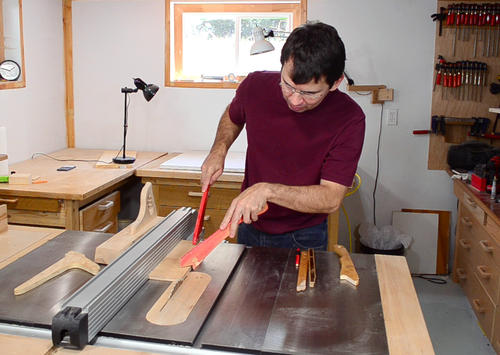
Photo credit: Woodgears.ca
With most push sticks, the tool has a hook or angle that attaches to the wood stock's back. Once you've placed the device appropriately on your wood, push the wood through from behind.
A push stick's main requirements are that it must apply adequate pressure, attach properly, and keep you a safe distance from the blade.
Safety Considerations for Table Saw Push Sticks
The best table saw push sticks offer the following safety considerations:
Positioning
Where you position your pushing tool on your stock significantly affects how well you make your cut. If you set your pusher too far to the left on a broad piece, it’ll swivel to the right. If the stick is placed too far to the right, the stock will swivel to the left. Finding the center point is vital if you need to use a push stick. However, a piece of stock that's broad enough to swivel is usually big enough to maneuver safely with your hands as well.
Type of Push Stick
Different designs of pushing devices have various safety ramifications. The ever-popular thin push stick with the bird's mouth grip places pressure on the stock's edge. Placing pressure at one edge of the wood typically causes the other to lift, creating a safety hazard.
However, the flat type design often incorporates a handle that your hand fits into. If you manage to create a kickback, that handle can snap your wrist. It can also pull your hand into the blade if the push stick gets caught.
Push Stick Length
Using a short push stick is asking for trouble. If you're running your hand an inch behind the stock on a tiny push tool, you're in as much danger as when using your bare hands.
You also don't want an overly long stick, as that lessens control. Aim for a tool that is between 16 and 18 inches.
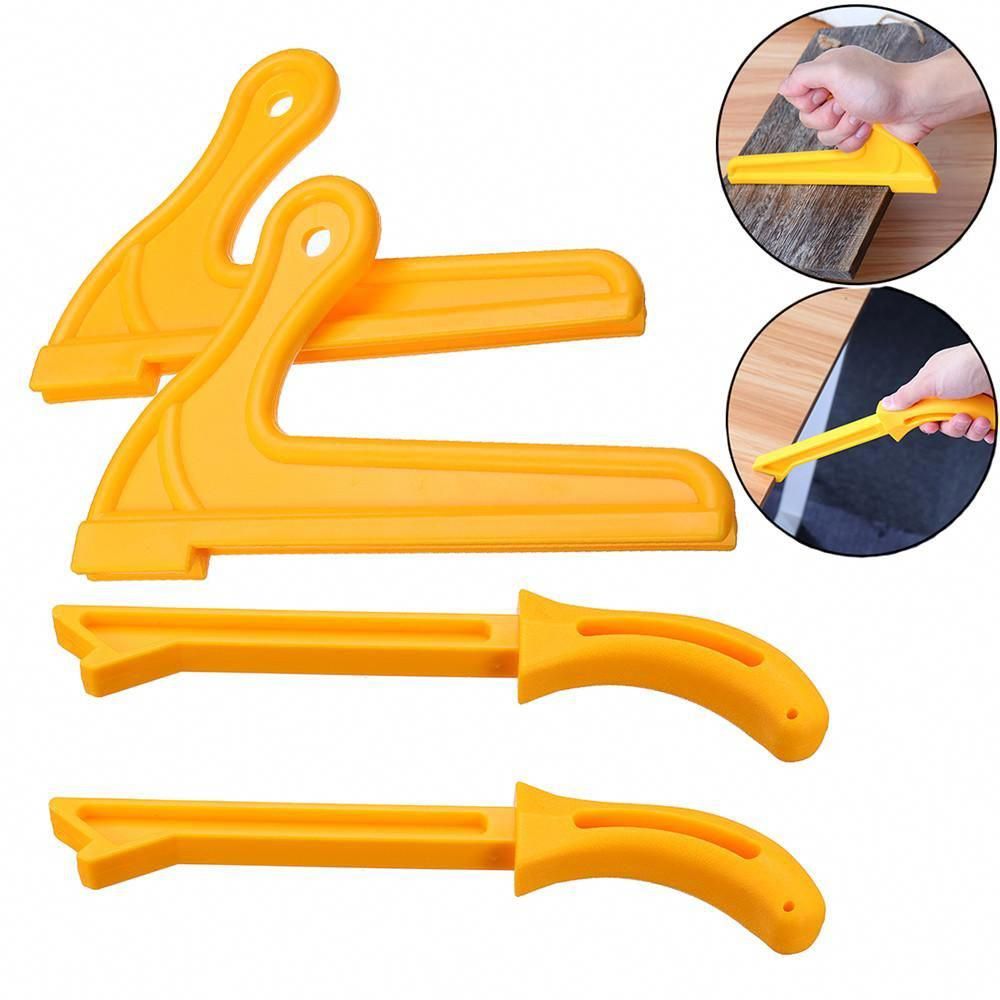
Photo credit: OhioEyeCareConsultants.com
How to Use Table Saw Push Sticks
When you've just purchased your first table saw, using the push stick can seem like a daunting task. Let's take a step-by-step look at how to use these tools appropriately.
1. Align your wood stock with the rail of your saw. Keep the wood well back from the blade.
2. Look at the wood's width to determine if you can start the cut using your hand. If the stock is under three inches wide, use the pushing tool.
3. Align the heel of the stick with the back of the stock. If you're using the standard push stick, align the ”bird's mouth” at the end with the wood.
4. Find a place on the wood where you can apply pressure without skewing the stock to either side.
5. Activate the saw.
6. Position the pushing tool on your predetermined location and apply pressure carefully from behind. Use your second hand or a secondary stick to apply pressure and keep the stock against the rail.
7. Keep pushing until the entire length of stock has gone through the blade.
8. Deactivate the saw.
9. Remove your wood pieces, which are now cut to size.
10. Celebrate your phenomenal success.
Conclusion
Table saws are fantastic tools, but they can be dangerous when not used properly. It's always a good idea to use a decent push stick when you're cutting stock with your table saw. Remember that the best pushing tools are affordable, secure, and comfortable to use. In short, keep your fingers, use a push stick.
People Also Ask
We've compiled a list of questions that new table saw users ask regularly. Below, you'll find detailed answers to some of your most common questions.
When Should You Use a Push Stick on a Table Saw?
You should always use a push stick or block for cutting the last 12 inches of your stock. Until that point, your hand will give you a more secure grip. As a rule of thumb, employ the pushing tool as soon as you can see the table beneath the wood's rear edge.
What Is the Minimum Length of a Push Stick?
A push stick should never be less than 16 inches long to maintain a safe cutting distance. Many commercial tools are as short as seven inches, putting your hand in the danger zone. An obvious exception is a tool like the GRR-Ripper, which allows you to move your hand over the blade safely.
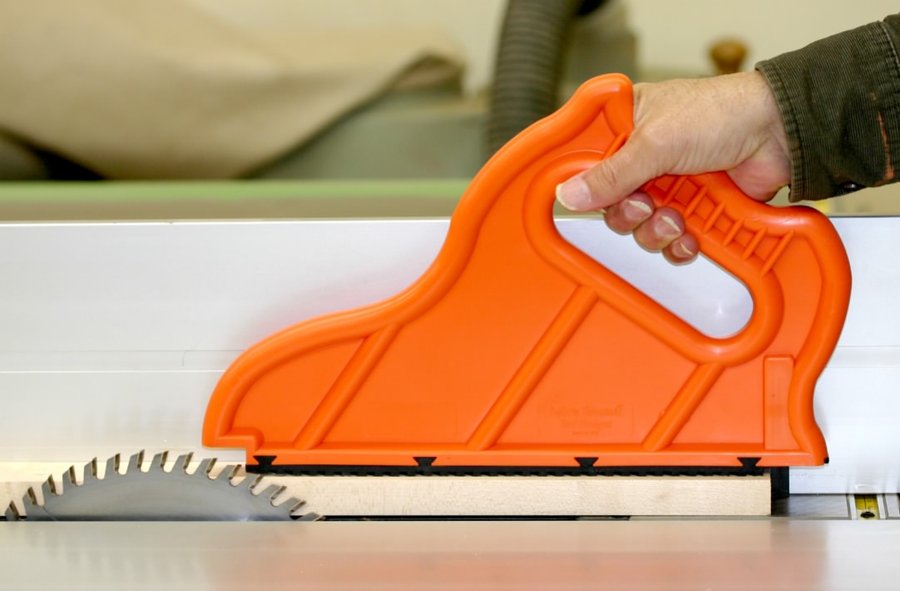
Photo credit: Lumberjocks.com
How Many Push Sticks for a Table Saw?
You typically need one push stick for a table saw. Run a hand alongside your stock, keeping it against the rail. Once you reach the final 12 inches, use a single push stick. If you use a narrow bar that applies pressure to the board's edge, you might need a second tool to control the stock.
What's the Difference Between a Push Block and a Push Stick?
A push block is essentially a type of push stick with more surface area. It's usually a larger rectangle rather than a narrow bar. Push blocks can be useful since they apply pressure to a larger area, giving you more control over the stock.
Are Push Sticks Really Necessary for a Table Saw?
If you're only going to cut stock that leaves over three inches of space between you and the blade, you don't need a push stick. However, most projects require significantly smaller cuts, for which you'll require a push tool. It's usually wise to use a push stick for the last 12 inches of any maneuver.
